Andrew Forrest takes a deep dive into ocean research
He’s made billions digging the earth. Now Andrew Forrest has turned his attention to a grand research project measuring the bounty of the world’s oceans.
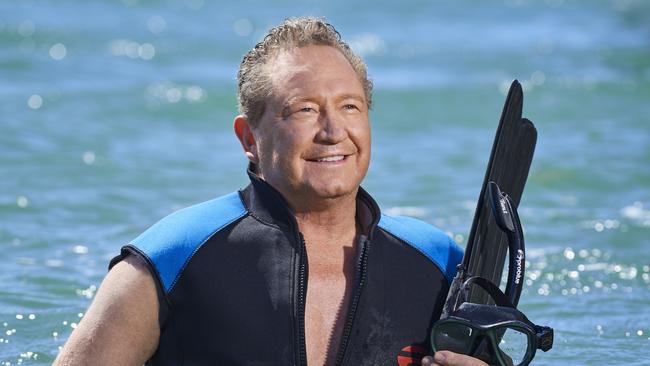
The Pangaea Ocean Explorer is not your typical billionaire’s boat. Yes, it is big, and yes, it is expensive. But in a line-up of superyachts in Cannes or Portofino, the Pangaea, with its oversized bow, would be the ugly duckling. It is a boat that looks like it would be more at home carving through heavy swells in real oceans than partying in the Mediterranean.
Rather than being just another toy of the super-rich, the Pangaea is at the core of a wildly ambitious scientific project that has the potential to fundamentally rewrite the world’s understanding of the oceans. It belongs to Andrew “Twiggy” Forrest, the billionaire iron ore baron and entrepreneur who is reinventing himself as a philanthropist and conservationist. On board the Pangaea, Forrest and his team of researchers are working on a project that is classically Twiggy-like in its scale and ambition – a radical plan to measure the diversity and size of the world’s sea life population.
Over tea in the Pangaea’s main saloon, Forrest is displaying his signature enthusiasm and rhetorical flourish, which previously coaxed billions out of investors for his mining projects, as he describes his plans to deliver what he says is the “holy grail” of marine conservation. “This is not an academic exercise, this is reality and it’s upon us right now,” Forrest says. “We are at a tipping point for the oceans. And if we don’t understand it now, we cannot preserve it now, and if we can’t preserve it now, we’re done.”
Forrest and his team see their OceanOmics project as a modern-day version of Charles Darwin’s voyage; the Pangaea is to Forrest what the HMS Beagle was to Darwin. Pangaea and a fleet of planned sister ships will collect water samples from sites across the world, and using cutting edge laboratory and computer technology will study the billions of traces of DNA harvested from that water to accurately measure the range of fish species present in the area. The field of analysing DNA collected from the environment, or eDNA, has taken huge strides in recent years. Perhaps its best-known application to date has been in the testing of sewage for traces of Covid.
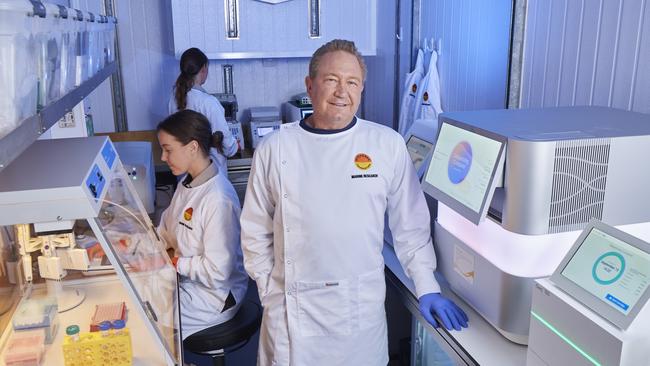
If successful and scaled up, these eDNA technologies will yield a greater understanding of the health of the world’s sea life and allow for monitoring of changes in marine populations. It would have significant implications for the way the world’s oceans are managed, giving governments crucial data when considering commercial fishing and protection requirements.
Forrest has always been a man of almost manic intensity, ambition and the sort of bottomless self-belief that saw him build an iron ore empire from the shadow of his Anaconda Nickel failure. That energy is now being funnelled into his reinvention as a philanthropist. This marine project is just the latest in a long line of moon-shot ambitions to emerge from Forrest’s philanthropic arm, the Minderoo Foundation, in recent years, including his plans to eliminate slavery, cancer, deadly bushfires and plastic waste. The OceanOmics study is also a grand extension of Forrest’s PhD thesis in marine science, completed in 2019.
The main way of estimating the abundance of marine life has involved researchers trawling swathes of ocean, scooping up stuff in nets, and then counting the haul of dead specimens back on the ship’s deck. The use of underwater cameras has provided a non-lethal alternative, but it is laborious, and of course they only record the fish that happen to swim past the lens.
“Once we can work out that abundance without killing anything or without investing years of researchers’ time standing in front of a computer, and do that at a fraction of a cent and in a fraction of a second, we can light up the ocean,” Forrest says. “We will know the populations of these oceans, are they increasing or declining, and if they are declining, why? If we can do that, we can avoid those precipitous declines and the denuding and desertification of our oceans.”
Forrest isn’t the only person investigating the potential of eDNA. Olly Berry, the leader of CSIRO’s Environomics Future Science Platform, describes himself as a “massive enthusiast”. “It genuinely will be a transformational technology for how we monitor biology, biodiversity and biosecurity in the ocean,” he says. What sets Forrest’s efforts apart from other researchers is his capacity to accelerate the deployment of eDNA at scale. “That might be something they are uniquely able to do,” Berry says.
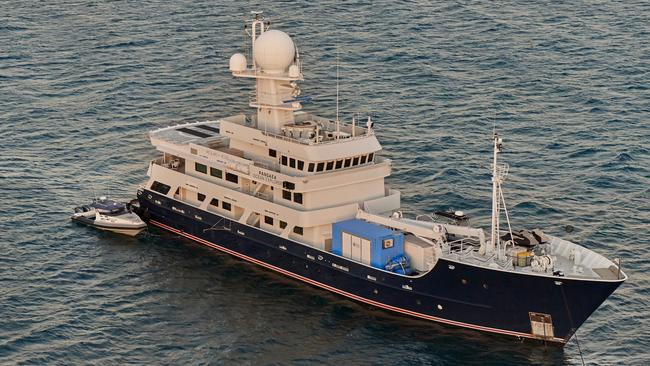
The Pangaea was already kitted out as an exploration vessel when Forrest bought it in 2018, but he has taken its scientific capacity to a new level since then. The pleasure craft that used to sit on the Pangaea’s foredeck are gone, replaced by a seatainer filled with some of the most advanced DNA research equipment available today. A large equipment locker at the stern has been emptied of jetskis and the like and converted into a wet lab, where marine researchers carry out the first stage of studying collected seawater samples.
The Pangaea’s main saloon, still largely fitted out as it was when Forrest bought the boat, has wood-panelled walls covered in old maps and etchings and curios such as tribal masks and taxidermied puffer fish. Even there, though, are reminders of the scientific mission in the form of monitors that display a live feed of the data and findings of the research equipment.
The man leading the OceanOmics research is Steve Burnell. A marine ecologist by training, he spent 15 years involved in cancer care focusing on genomics – the study of genomes, the complete set of genetic information carried by an individual – and single-cell sequencing of cancer patients. Having witnessed first-hand the role of genomics in cancer care, Burnell was struck by the potential to apply that science to his first love: the ocean.
Central to the potential of Forrest’s research is the fact that sea water is incredibly good at preserving DNA and cellular material. Just one millilitre, Burnell says, can contain thousands of fragments and hundreds of cells. The vast majority of those fragments – some 99.9 per cent – will be from bacteria and other single-celled organisms. As part of the work, Minderoo is honing systems that will quickly identify and isolate the 0.1 per cent of the material that comes from all the other sea life in the ocean, from fish to whales to turtles.
From there, those DNA fragments will be sequenced and matched against a fish genome dictionary that Minderoo is also helping to develop. The lack of information about the DNA of specific fish species is one of the many challenges that Minderoo has to overcome. Currently, of the 20,000 known saltwater fish species, only 200 have had their genomes publicly published. Minderoo has published another 18 already off the back of its recent expeditions, and is working with the University of Western Australia to set up a system that will identify and publish the genomes of around 1500 species a year. That dictionary will then become the reference for each piece of DNA that is sequenced on board the Pangaea.
Forrest says the volume of data Minderoo will harvest, coupled with the comparative lack of understanding of the world’s sea life, makes it almost inevitable that the DNA of previously unknown species will be detected. “We understand much more about the surface of the Moon and Mars than we do about the Indian Ocean,” he says.
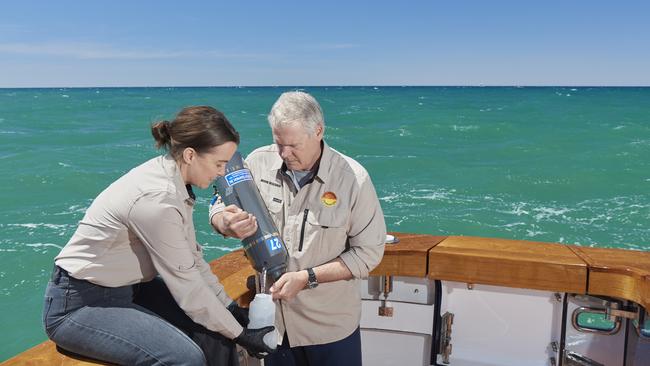
One of the project’s biggest challenges will be putting the enormous reams of data it will collect to use. Professor Damien Burrows, the director of James Cook University’s Centre for Tropical Water and Aquatic Ecosystem Research, says that while the scale of Forrest’s efforts stand out, it does risk being “overrun” by information. “One of the challenges we’re facing now in science and technology is there is an exponential increase in the rate at which we can collect information in the field, but the rate at which we can deal with it and process it and write it up isn’t keeping pace,” he says. “We are facing this problem of being deluged with data that doesn’t always translate to knowledge and understanding.”
The magic fairy dust of scientific research and exploration is capital. Columbus had Queen Isabella and King Ferdinand, Darwin’s berth on the HMS Beagle was funded by his father, while Forrest has an income stream that allows him to chase any idea he wishes. His passion for marine science is real but more important is the steady stream of huge dividends pouring in from Fortescue. In August, he collected a $2.4 billion cheque from a bumper six months for the company. The current program to determine the feasibility of the research will cost tens of millions. Expanding it will cost multiples of that.
As Burnell points out, though, DNA sequencing is following a similar trajectory to Moore’s Law – the observation that the capacity of a computer microchip doubles and its cost halves every two years. “If you can then take that innovation and drive down the cost and scale it, which is something that Dr Forrest has been pretty good at doing in other industries, that is where this suddenly becomes a game-changer,” Burnell says. “This will give us a range of information about species that blows away everything we’ve ever had.”
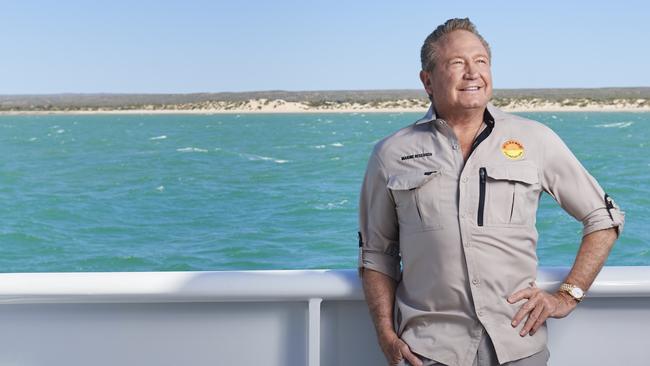
Forrest has written an academic paper spelling out his vision for Panthalassa, another dedicated research ship named after the single massive ocean surrounding the supercontinent Pangaea that was once Earth’s only landmass. The trimaran would be a floating research centre decked out with an array of autonomous aerial, surface and underwater drones that would collect data and monitor for illegal fishing, and onboard data processing. Under Forrest’s vision, Panthalassa and dozens of ships like her will be plying the world’s oceans in the years to come.
In September, Forrest formally opened a new research laboratory at Exmouth, on the doorstep of Western Australia’s UNESCO World Heritage-listed Ningaloo Reef, which will help support Minderoo research projects while also becoming a hub for other marine researchers.
During his reinvention from entrepreneur to philanthropist, Forrest has not lost his knack for deal-making. He secured the building for the Exmouth lab from the state government for a peppercorn rent after difficulties in securing a suitable tenant for the site, although Minderoo has spent several times the $2.5 million it had promised to invest in completing the building’s fit-out as part of that deal. And he wants to see other research organisations and governments step in as partners on the project and deliver the dozens of research labs that a global rollout will require.
When Forrest first sketched out his Fortescue iron ore plans, he was ridiculed and derided by established iron ore producers and many investors in the market. The billions of dollars pouring out of the Pilbara and into Forrest’s pockets is his vindication. Burnell is increasingly confident that the OceanOmics project will follow the same path. “In the last year, it’s gone from a lot of sceptics saying it’s impossible to – I think we’ve shown that, actually, we’re going to get there now, we can scale this model.”


To join the conversation, please log in. Don't have an account? Register
Join the conversation, you are commenting as Logout